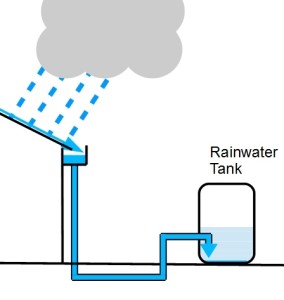Charged Rainwater Collection
Thanks to SaveH2O, of Supadiverta
This diagram indicates a charged rainwater collection system. These are sometimes called either a “wet” or a “pressure” system.

NB. This diagram has been simplified for clarity. A leaf diverter, and an adequate overflow, must also be fitted.
With this type of system a section of the pipework always remains full.
As the pipes are under pressure it is essential all the joints in above ground and underground pipework are fully watertight.
ADVANTAGES
- Allows you to discharge water at a height above the ground level at the down pipe (But not at the top of the tank – see the post: Inlet Improvements)
- Neater than above ground pipework
- Additional down pipes can be connected without diverting pipes along walls.
DISADVANTAGES
- It is more likely to block as the flow through the pipes can be fairly slow and the low points can collect silt. (It is also more difficult to unblock.)
- Higher cost than above ground systems due to trench excavation, and additional inspection fittings.
- Potential for mosquito breeding in water unless appropriate screes are installed.
- Harvesting additional downpipes without adequate overflow capacity can result in the tank overtopping during heavy rain.
Also see Underground Pipes